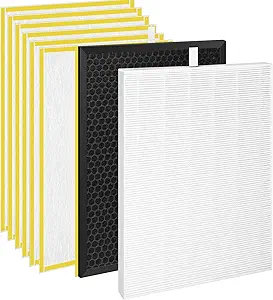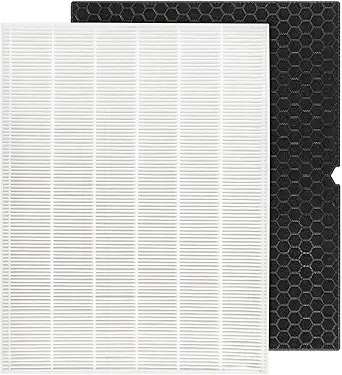Understanding the Role of Air Purification in Allergen Control
Indoor air quality has become an increasingly important concern for homeowners and health-conscious individuals. With rising pollution levels and a growing awareness of airborne allergens, many people turn to air purifier filters as a solution for cleaner, healthier indoor air. These sophisticated devices promise to trap and eliminate various airborne particles that trigger allergic reactions and respiratory issues. However, understanding their true capabilities and limitations is crucial for making informed decisions about indoor air quality management.
Modern air purifier filters employ advanced technology to combat common indoor allergens such as dust mites, pet dander, pollen, and mold spores. While these devices have revolutionized indoor air quality control, it's essential to examine their effectiveness realistically and understand how they fit into a comprehensive strategy for allergen management.
The Science Behind Air Purifier Filtration Systems
HEPA Technology and Its Impact
High-Efficiency Particulate Air (HEPA) filtration stands at the forefront of air purifier filter technology. These filters can capture particles as small as 0.3 microns with an efficiency rate of 99.97%. This impressive capability means that most common allergens, which typically range from 0.3 to 100 microns in size, can be effectively trapped within the filter's intricate mesh of fibers.
The filtration process involves multiple mechanisms, including interception, impaction, and diffusion. As air passes through the filter, larger particles are caught directly by the fibers, while smaller ones are trapped through various physical phenomena. This sophisticated system ensures that even microscopic allergens are removed from the circulating air.
Advanced Filtration Technologies
Beyond HEPA, modern air purifier filters often incorporate additional technologies to enhance their effectiveness. Activated carbon filters excel at removing odors and gaseous pollutants, while UV-C light technology can neutralize biological contaminants. Some advanced models also feature ionic filtration, which charges particles for easier capture.
These complementary technologies work in concert to provide comprehensive air purification. While HEPA handles particulate matter, these additional layers ensure that a broader spectrum of air quality issues is addressed, creating a more complete solution for allergen control.

Effectiveness Against Common Allergens
Capturing Different Types of Allergens
Air purifier filters demonstrate varying levels of effectiveness against different types of allergens. Pollen, being relatively large at 10-100 microns, is easily trapped by most quality filters. Pet dander and dust mite debris, ranging from 0.5-20 microns, are also effectively captured by HEPA-grade filtration systems. Mold spores, typically 1-30 microns in size, are likewise efficiently removed from the air.
However, the effectiveness of filtration depends not only on particle size but also on other factors such as air flow patterns, room size, and the specific characteristics of different allergens. Some particles may be more challenging to capture due to their shape, weight, or electrical charge.
Real-world Performance Metrics
Laboratory testing has shown that high-quality air purifier filters can remove up to 99.97% of airborne particles when operating under ideal conditions. However, real-world performance may vary due to environmental factors, maintenance levels, and usage patterns. The actual effectiveness in a home setting typically ranges from 50% to 90% reduction in airborne allergens, depending on various factors.
Regular monitoring and maintenance are crucial for maintaining optimal performance. Filters must be replaced according to manufacturer specifications, and the unit should be appropriately sized for the space it's meant to clean.
Maximizing Allergen Removal Efficiency
Optimal Placement and Usage
The effectiveness of an air purifier filter largely depends on its placement within a room. Positioning the unit away from walls and furniture allows for optimal air circulation. For best results, place the purifier in areas where you spend the most time, such as bedrooms or living rooms. Multiple units may be necessary for larger spaces or homes with open floor plans.
Operating the air purifier continuously, rather than intermittently, ensures consistent air quality. Many modern units feature automatic modes that adjust filtration levels based on detected air quality, optimizing both performance and energy efficiency.
Maintenance and Filter Care
Regular maintenance is crucial for maintaining the effectiveness of air purifier filters. This includes timely filter replacement, cleaning of pre-filters, and ensuring that air intake vents remain unobstructed. Different components may have varying replacement schedules – while pre-filters might need monthly cleaning, HEPA filters typically last 6-12 months.
Monitoring filter condition and following manufacturer guidelines for maintenance helps maintain optimal performance. Some advanced models include filter life indicators, making it easier to track when replacements are needed.
Comprehensive Approach to Allergen Control
Supporting Strategies
While air purifier filters play a crucial role in reducing airborne allergens, they work best as part of a comprehensive approach to indoor air quality management. Regular cleaning, proper ventilation, and humidity control are essential complementary measures. Using allergen-proof bedding, regular vacuuming with HEPA-equipped vacuum cleaners, and maintaining appropriate indoor humidity levels can significantly enhance the effectiveness of air purification efforts.
Professional cleaning of air ducts, regular maintenance of HVAC systems, and addressing potential sources of allergens (such as leaks that could lead to mold growth) are also important components of a complete allergen control strategy.
Future Developments in Air Purification
The field of air purification continues to evolve with technological advancements. Smart air purifiers with IoT connectivity offer real-time air quality monitoring and automated adjustment capabilities. Emerging technologies such as photocatalytic oxidation and advanced molecular filtration promise even more effective allergen removal in the future.
Research into new filter materials and designs continues to push the boundaries of what's possible in air purification. These innovations may lead to even more efficient and comprehensive allergen removal systems in the coming years.
Frequently Asked Questions
How Long Should I Run My Air Purifier Each Day?
For optimal allergen removal, it's recommended to run your air purifier continuously. Modern units are designed for 24/7 operation and are most effective when maintaining consistent air filtration. If continuous operation isn't possible, aim for at least 12 hours daily, focusing on times when you're present in the space.
When Should I Replace My Air Purifier Filter?
HEPA filters typically need replacement every 6-12 months, depending on usage and air quality conditions. Pre-filters may require monthly cleaning or replacement. Many modern air purifiers include electronic indicators that signal when filter replacement is needed based on actual use and air quality conditions.
Can Air Purifiers Remove All Types of Allergens?
While high-quality air purifier filters are highly effective at removing most airborne allergens, they cannot remove all allergens completely. They work best on airborne particles and are less effective against allergens that have settled on surfaces. For comprehensive allergen control, air purification should be combined with regular cleaning and other environmental control measures.

